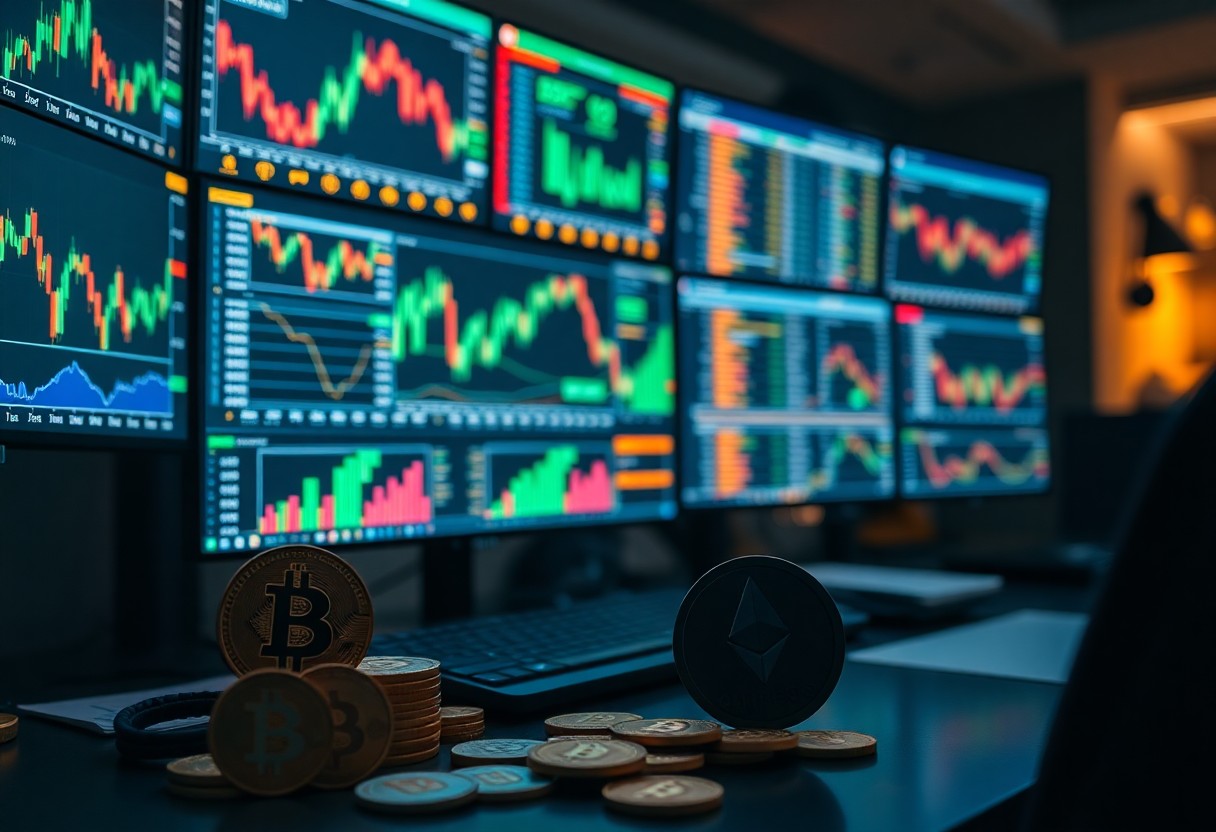What Are Crypto Derivatives and How Do They Work?
It’s crucial to understand that crypto derivatives are financial contracts whose value is derived from the price movements of underlying cryptocurrencies. These instruments, including futures and options, allow you to speculate on price changes or hedge against market volatility. Engaging with crypto derivatives can amplify your potential profits but also significantly increase your risk exposure, making it vital to grasp their mechanics before trading. By comprehending how they operate, you can better navigate the complexities of this burgeoning financial landscape.
Understanding Crypto Derivatives
A crypto derivative is a financial instrument whose value is derived from underlying cryptocurrencies. These contracts allow you to speculate on price movements without owning the actual digital assets. Various forms of crypto derivatives include futures, options, and swaps, each serving specific trading strategies and risk profiles.
Definition and Types
On a broad spectrum, crypto derivatives can enhance trading opportunities in the digital currency market. Here’s a breakdown of their main types:
| Type | Description |
| Futures | Contracts obligating you to buy/sell at a future date. |
| Options | Contracts granting the right but not the obligation to trade. |
| Swaps | Agreements to exchange cash flows or returns on assets. |
| Perpetual Contracts | Similar to futures but with no expiration date. |
| Leveraged Tokens | Tokens that provide leveraged exposure to asset price movements. |
After exploring these types, you gain insight into the various mechanisms available for trading crypto derivatives.
Key Features
Between the different crypto derivatives, you will encounter several key features that define their utility:
- Leverage: Amplify your exposure to price movements with less capital.
- Hedging: Protect against potential losses in your cryptocurrency holdings.
- Speculation: Engage in high-risk, high-reward trading strategies.
- Short Selling: Profit from declining markets by selling borrowed assets.
- Diverse Strategies: Use various approaches to meet your investment goals.
Knowing these features allows you to make more informed trading decisions with crypto derivatives.
Crypto derivatives offer you flexibility in trading strategies but also come with significant risks. Their inherent complexity and potential for high volatility make it critical to approach them with a robust understanding. Ensuring that you are aware of the implications of leverage, for instance, could prevent substantial financial setbacks. With various options available, you can tailor your trading approach to best fit your needs.
- Flexibility: Choose from numerous trading options.
- Market Access: Trade a variety of cryptocurrencies on different platforms.
- Cash Settlements: Some derivatives do not require the delivery of actual assets.
- Real-Time Pricing: Stay updated on market fluctuations.
- Regulatory Environment: Be aware of the legal landscape surrounding derivatives.
Knowing these aspects can substantially enhance your trading strategy in the crypto derivatives market.
How Crypto Derivatives Work
If you want to harness the power of cryptocurrency markets, understanding how crypto derivatives function is imperative. These financial instruments derive their value from underlying crypto assets, allowing you to speculate or hedge against price movements without directly owning the assets. You can enter contracts that involve futures, options, or swaps, which can amplify your potential gains and losses, reflecting the volatility of the crypto market.
Mechanisms of Trading
Derivatives can be traded on both centralized and decentralized exchanges. You will place orders for buying or selling contracts based on the price of the underlying asset, utilizing leverage to enhance your trading capacity. The speed and efficiency of order executions can significantly impact your trading outcomes, as well as the fees associated with each trade.
Settlement Methods
Work in crypto derivatives trading typically involves two primary settlement methods: cash settlement and physical settlement. With cash settlement, your profits or losses are paid out in cash, eliminating the need for asset transfer, while physical settlement involves the actual delivery of the underlying asset. Each method has its implications for your trading strategy and risk management.
In addition to these methods, timeliness and market conditions play important roles in settlement efficiency. You should take note that cash settlements can help you avoid the complexities of asset ownership, whereas physical settlements may expose you to market risks even after the contract ends. Choosing the appropriate settlement method can influence your overall trading strategy and financial outcomes.
Benefits of Trading Crypto Derivatives
It allows you to access a wide range of trading strategies and capitalize on market volatility. By utilizing crypto derivatives, you can enhance your potential returns while diversifying your portfolio. Additionally, these instruments can provide opportunities for profit in both rising and falling markets, making them an attractive option for savvy traders.
Leverage and Margin Trading
To maximize your investment potential, you can utilize leverage in crypto derivatives trading. This means you can control a larger position with a smaller amount of capital through margin trading. While this approach can amplify your gains, it also increases your risk, so it’s important to approach it carefully.
Risk Management Strategies
Margin trading can expose you to significant risks, making effective risk management strategies important. At all stages of your trading journey, be sure to implement measures such as setting stop-loss levels and diversifying your positions. By doing so, you protect your capital and limit potential losses, which is vital in the volatile landscape of cryptocurrency trading. Identify and analyze your risk tolerance to make informed decisions and continuously monitor market conditions to safeguard against drastic price movements.
Risks Associated with Crypto Derivatives
Not understanding the inherent risks of crypto derivatives can lead to significant financial losses. These complex financial instruments can amplify both gains and losses, making it vital for you to grasp their mechanics. Factors such as market volatility, regulatory scrutiny, and technological vulnerabilities can impact your trading outcomes, necessitating thorough research and risk management strategies.
Market Volatility
One of the primary risks you face when trading crypto derivatives is market volatility. The cryptocurrency market is known for its rapid price fluctuations, which can result in high leverage amplifying your potential losses. In this environment, timing and strategy become critical to avoid adverse outcomes.
Regulatory Concerns
On top of market volatility, regulatory concerns pose a significant risk to your investments in crypto derivatives. As governments around the world grapple with how to govern cryptocurrencies, inconsistencies in regulations can lead to abrupt market changes, impacting your trading positions.
Due to the evolving nature of regulations, you must stay informed about changes that could affect your trading strategies. Sudden regulatory shifts can result in increased compliance costs or even market bans, potentially leading to unanticipated losses. Furthermore, lack of clarity may expose you to legal risks, underscoring the importance of maintaining awareness of both local and global regulatory landscapes.
Popular Crypto Derivative Instruments
Despite the inherent volatility of cryptocurrencies, various derivative instruments have gained popularity among traders. These tools allow you to speculate on price movements, hedge exposure, and enhance your trading strategies. Common instruments include futures contracts, options contracts, and perpetual swaps, each offering unique benefits and risks that can influence your trading decisions.
Futures Contracts
Futures contracts are agreements to buy or sell a specific cryptocurrency at a predetermined price on a future date. They enable you to lock in prices, providing a hedge against market fluctuations. However, you must be aware of the risks associated with leverage and the potential for substantial losses, making understanding market trends vital.
Options Contracts
Against the backdrop of market volatility, options contracts grant you the right, but not the obligation, to buy or sell a cryptocurrency at a set price before expiration. This gives you flexibility in managing risk and can be a valuable addition to your trading toolkit.
A key advantage of options contracts is their ability to limit your downside risk while allowing for potential profit through strategic positioning. Keep in mind, however, that while you can choose not to execute an option, the premium you pay may become a loss if not utilized effectively. Additionally, the complexity of options strategies can pose challenges if you lack experience, potentially exposing you to greater risks. Understanding the implications of time decay and volatility is vital for maximizing your success.
The Future of Crypto Derivatives
Your engagement with crypto derivatives will increasingly shape your investment strategies as they evolve. The growing sophistication of financial instruments will likely open new avenues for risk management and speculative opportunities. As institutional interest rises, you can expect enhanced liquidity and innovative products that may redefine the landscape of digital finance.
Market Trends
At the forefront of market trends, you will notice a significant increase in the adoption of crypto derivatives, driven by institutional investors seeking to hedge risks. Enhanced trading volumes and new product offerings will continue to emerge, creating a dynamic environment where you can capitalize on volatility and market movements.
Evolving Regulations
An important aspect you should consider is the evolving regulations surrounding crypto derivatives. These regulations aim to enhance transparency and protect investors while fostering market integrity.
Derivatives markets are facing increased scrutiny, as regulatory bodies aim to implement comprehensive frameworks to mitigate risks associated with trading. As a participant, you should be aware that compliance with these regulations may affect your trading strategies, potentially increasing costs but also enhancing market stability. The push for regulation could lead to a more trustworthy environment, encouraging broader adoption of crypto derivatives among both retail and institutional investors.
Conclusion
With these considerations, you can better understand crypto derivatives and their role in the digital asset market. These financial instruments enable you to hedge risks or speculate on price movements without owning the underlying cryptocurrencies. By grasping the mechanics of futures, options, and swaps, you can make informed decisions that align with your investment strategies. As the crypto landscape evolves, staying updated on these instruments will enhance your ability to navigate this complex but promising market.






